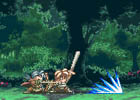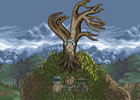Tales of Phantasia
| Also Known As: ToP | ||
| Genre: RPG | ||
| Platform(s): SNES/PSX/GBA | ||
| Allegiance: Namco | ||
| Vintage: 1995 | ||
| Rating: T | ||
| Intelligence Agency Report by: Kuzu Ryu Sen | ||
| On his 15th birthday, Cless Alvein received a pendant from his father for his birthday. Thinking nothing extraordinary of it, Cless treated it like any other present from his parents. Five years later, as he and best friend Chester Barklighter walk into the forest south of their hometown of Totus, they have no idea that Cless’ pendant is about to trigger a major event, one that will introduce new friends, new experiences, new worlds, new trials, and old secrets. | ||
|
|
||
| Weapons Expert Report by: Kuzu Ryu Sen | ||
| Story/Premise Gameplay Impact Visual Audio |
9.25 9.00 10.00 9.50 9.50 |
|
| Overall | 9.75 | |
| (not an average) | ||
| Version Reviewed: SNES, DeJap Translation
Five minutes. Thats all it took for me to get completely addicted to Tales of Phantasia. Featuring an outstanding plot, standout characterization, beautiful graphics, emotion invoking music, and one of the most unique battle systems at the time, Tales of Phantasia provided an entertaining, moving, and above all, a very powerful gaming experience. Enough to beat out Final Fantasy VI as the best RPG for the SNES. Regardless of whether the RPG is linear or non-linear, the most important part of any RPG is gameplay. It’s the gameplay that determines the replay value of the game, and whether the plot is worth revealing. With Tales of Phantasia, Namco unveiled their side scrolling real time battle system, instead of using a standard “select attack from menu” battle system. While this system takes some time to get used to, it ensures that no two battles are ever the same, and battles cannot just be won by mashing the attack command. Skills can also be utilized in real time, and are divided into long range and short range skills. Even more impressive than the array of skills that can be learned in the game are the combination techs, the product of mastering two separate skills through repeated use. Tales of Phantasia also features a wide plethora of items, including the rune bottle, used to transform items into other items (for better or worse). All in all, this game has fantastic gameplay, and amazing replay value, especially due to the hidden “Hard Mode” that makes battle strategy absolutely critical to success. While gameplay may be the most important aspect of any RPG, without plot and characterization, no linear RPG can achieve true greatness in the upper echelon of the genre. Without revealing too much, Tales of Phantasia has a wonderful plot, and while it’s not overly deep, philosophical, or complex, it has a more important quality: it’s emotionally powerful. The characters all have their own very unique personalities (made more so by DeJap’s rather… liberal translation), and have their fair share of moments to shine. From an audio/visual aspect, this game may be the finest game graphically for the SNES. Featuring fantastic character designs by Fujishima Kosuke (Ah! My Goddess, You’re Under Arrest), exquisite backgrounds, and vibrant battle animation, Tales of Phantasia is a feast for the eyes. Tales of Phantasia was also one of the first games to ever feature voice acting, including a full-length J-pop opening song. The soundtrack by Sakuraba Motoi is very good, not quite up to Uematsu Nobuo’s works, but it has it’s own charm, and complements the rest of the game very well. What this game truly shines at is attention to detail, from footprints, to falling snowflakes, to leaves falling in the breeze, to sagging bridges. One of the prettiest and best sounding games ever produced for the SNES. There are not a whole lot of major weaknesses with Tales of Phantasia, but one of them is that micromanagement is very difficult. Because of the nature of the battle system, it is all but impossible to control your entire party and yet still maintain a fast paced exciting battle. As such, one has to rely on the AI to control the other members of the party, and that could lead to some serious headaches, particularly in the form of unwanted spell casting. While the AI is fairly intelligent, it will occasionally slip up, and heal your opponents, or cast a worthless death spell. The only other flaw is that the random encounter rate is staggering. While in a cave or dungeon, one can expect a battle every ten steps or so, and it is almost impossible to travel through one screen without a random battle. Thank god that they’re so fun. Nevertheless, Tales of Phantasia remains one of the best games to ever be produced for the SNES, and one of the games that showed what the SNES was truly capable of in terms of hardware performance. Unfortunately, this game never made it to this side of the Pacific, making Tales of Phantasia one of the most underrated games ever created. DeJap Translations has produced a translation patch for the game, albeit having taken a few liberties with the script. The game has also been ported to the PSX and GBA, but there were enough changes between versions that each merits its own review. Don’t miss out on this gem from Namco!
|
||




